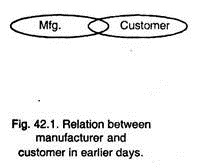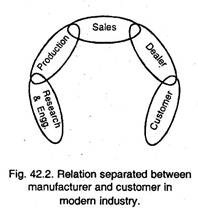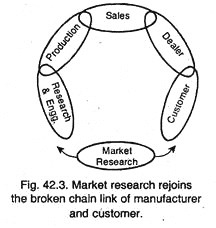After reading this essay you will learn about:- 1. Meaning of Market Research 2. Characteristics of Good Marketing Research 3. Necessity 4. Undertaking Market Research 5. Functions 6. Classification 7. Techniques.
Essay Contents:
- Essay on the Meaning of Market Research
- Essay on the Characteristics of Good Marketing Research
- Essay on the Necessity of Market Research
- Essay on Undertaking Market Research
- Essay on the Functions of Market Research
- Essay on the Classification of Market Research
- Essay on the Techniques for Conducting Market Research
Essay # 1. Meaning of Market Research:
Market research is the analysis of a project to be started, expanded or modified. Broadly speaking market research is the commercial research for the suitability of a business and is a continuous process i.e. research is always kept continued for the stability of the business.
Market research is very essential in mass scale production because volume of production depends upon the continuity of demand. If demand reduces suddenly, production comes to a stand-still, which may produce great losses to manufacturer.
Market research includes forecasting, intelligence and statistics. It is an important factor for the sale of products. Failure to do this accurately may lead to the production of more goods than the market can absorb, which means financial losses to the firm. It may also lead to under production, the results of which are equally unpleasant.
Market research may be defined as a way of finding out facts which must be known before a market policy is to be determined. Before starting a business, planning department makes different investigations affecting the business to maintain good working conditions, better quality and handsome profits.
“Many new products” and firms fail because they start business on a “Guess-estimate” of the good market but that is never reached. Therefore, investment of small amount and time on careful market analysis is comparatively better instead of bigger loss at a later stage.
The market analysis is a scientific method of determining what to produce, who the purchasers are, where these are located, how much to manufacture, how to sell and when to sell, in order to maximise the service rendered and the profits earned.
This is a dynamic world in which the profit opportunities are constantly altering and efficient market research can only enable a manufacturer to earn maximum while giving the customer maximum satisfaction.
Continued success in business depends on its maintaining a continuous flow of new product ideas. Thus owner should select only profitable products and leave unprofitable ones. These ideas mainly originate in the sales or research organisations.
Mainly the object of market research is to inform the management as to what the future holds good for its products and proposed products.
The market research data can be collected from the internal records of the business, reports obtained by outside sales staff, published sources, investigators in the field, financial and trade formulae and reports of trade associations.
The analysis of the product is made to find out:
(i) Sales volume.
(ii) Amount of profit and its duration.
(iii) Amount of capital needed.
(iv) Cost of necessary advertising.
(v) Production cost.
(vi) Stability of new material supply.
(vii) Business conditions and trends.
(viii) Handling and transportation charges.
(ix) Seasonal market characteristics.
(x) Any other factors which may be considered related to the success of the business.
Essay # 2. Characteristics of Good Marketing Research:
1. Effective marketing research uses the principles of scientific method, careful observation, prediction and testing.
2. Marketing research develops innovative ways to solve a problem.
3. Good marketing researchers should avoid over reliance on any one method. They also recognise that using multiple sources leads to better information.
4. Good marketing researchers recognise that data are interpreted from underlying models, and these models guide the type of information sought.
5. Good marketing researchers show concern for estimating the value of information against its cost. This helps in deciding which research project should be conducted.
6. Good marketing research benefits both the sponsoring company and its consumers. Through these, company learns more about consumers’ needs and is able to supply more satisfying products and services.
Essay # 3. Necessity of Market Research:
The necessity of market research which is a new technique existed in the 20th century due to the industrialisation of Western society in the 19th century. The necessity improved greatly due to introduction of large scale production and large increase in population.
In the earliest days there was less gap between the initial manufacturer and the ultimate consumer. Fig. 42.1 shows this relation. The manufacturer knew his customer’s demands, desires and habits. They were very close to each other because of few in number.
Now modern industry separated customers by complicated organisation and engaged in mass production for cheap and large scale demands. Therefore, the demands of the customers must be explored, developed and evaluated.
The change from intimate manufacturer and customer contact is similar to a broken circular chain as shown in Fig. 42.2. Fig. 42.3. shows how market research brings manufacturer and customer close to each other.
Essay # 4. Undertaking Market Research:
The work of market research should be handed over to the sales department. Throughout the research, scientific methods are used so that nothing is overlooked. The reasons for the various features of the market demand are made clear and generally the maximum information is obtained.
The analyst should first make the preliminary survey suggested by the directors. Since the preliminary survey is the foundation around which a more extensive study may be practised later.
Therefore, it should be conducted only by an alert and experienced analyst who can make out plans for future operations efficiently. Sometimes a preliminary survey supplies sufficient information that there is no profitable market for the products and hence further analysis is not required.
The collection of several data in survey is generally the most exhausting and frustrating part. The various mediums used, can be questionnaire, telephone, personal contacts and interviews. The personal contacts and interviews are the best media as they give comparatively true and correct information though costly and take more time.
Essay # 5. Functions of Market Research:
Following are the main functions of market research:
1. It helps in knowing that who and where the customer is and what he wants.
2. It helps in knowing the sale trend, market potential and its shares in the market, which is essential for production planning.
3. It helps in knowing the defects in the products and reasons of resistance by consumers and then to rectify them in future production.
4. It studies the distribution channel and its effectiveness.
5. It exploits new markets and helps developing new products.
6. It safeguards the interest of the company against changes in the market in future.
7. It keeps the business in touch with its market and thus helps the sales promotion efforts.
Essay # 6. Classification of Market Research:
Market research is sub-divided into four general classifications as described below:
(a) Product Analysis.
(b) Market Analysis.
(c) Distribution Analysis.
(d) Competition Analysis.
(a) Product Analysis:
Product analysis is required to find out customer’s preferences for the product. This will enable management to make improvements that will meet the requirements of customers. These will fulfill the present requirements of the market and will be more acceptable than those of competitor’s products.
Product analysis is also carried out to simplify product lines by eliminating those which have a limited demand, or are unprofitable, to determine the method of packing that will bring best sales and to find the suitable price which may be accepted by the customers and results in handsome profits.
It is important to find what characteristics your products have and which other competitor’s products have not, in order to know their relative advantages so that customers can be persuaded to purchase your products only.
A check list of questions to be answered by a product analysis is given below:
1. Whether the product fulfills market requirements.
2. Whether the product competitive in character, performance and price.
3. Whether the product permits efficient distribution.
4. Whether the product can be sold at handsome profits.
5. Whether the lines complete the required sizes.
6. Whether some design improvement are required to fulfill customers’ needs and improve performance.
7. How product can be redesigned to reduce cost of production, packing, distribution, transportation and maintenance without affecting quality?
8. Whether reduction of a selling price has effects on demand.
9. Whether finished stock can be reduced to minimise investment, warehouse costs and obsolescence.
10. How repairs and replacement methods can be improved?
11. What is the future trend of changes as determined by customers’ changing habits?
12. What new changes and inventions are likely to occur?
13. What is competition offering? Whether some better design ideas can be taken from competitor’s products.
(b) Market Analysis:
The object of market analysis is to find the location of markets, scope of sales and buying habits of customers that make up the potential market for a product. As the size of industry increases with the consumption of products, therefore, this fact is required for deciding about the capacity of plant and machinery.
A check list of questions to be answered by a market analysis is given below:
1. Who purchase the product?
2. Where are the markets?
3. How many other customers influence the purchase?
4. What is the volume of sale during a particular time?
5. On what factors buyers pay stress e.g. quality, price, delivery, safety or service etc.?
6. When customers are mostly in the habit of buying?
7. How often they used to purchase?
8. Do they buy in advance of needs?
9. Whether demand is seasonal?
10. What discount and credit terms are prevailing?
(c) Distribution Analysis:
This consists of the study of the channels of distribution, methods of pricing, resale price, maintenance, selling methods, sales promotion, sales training, warehousing, distribution, cost analysis and other policies and practices required for the product distribution.
The economic selection of the best channels of distribution for a product is essential for the success in market analysis. It includes transportation, warehousing and inventory costs.
(d) Competition Analysis:
Competition studies are generally included as a part of marketing analysis. This makes necessary to study the recent or proposed production sales and pricing policies of the competitors.
Most important of these is the analysis of the quality of competitor’s products to ascertain how a potential customer would compare with one’s own products.
The sales department should ask its salesmen to report and comment by potential customers about the firm’s product or the products of its competitor’s. It should also study the research and product development work that the competition may be carrying on in order to estimate how these will affect its further sales.
From these studies, plans and policies may be made to guide future activities of a concern in order to improve its competitive position.
Essay # 7. Techniques for Conducting Market Research:
To carry out various analysis as explained above, following techniques are adopted:
1. Collection of Data:
Since these data are on the table of the organisation, this technique is also known as Desk research. In this method, the data are collected from published material (either by the company itself or by other agencies e.g. Journals of the trade, published survey reports, Government publications, international publications etc.).
This type of research is carried out for knowing past sales, effects of various factors on sales in the past, fluctuation in the sales etc.
2. Interviews:
To know the views of salesmen,-dealers and consumers interviews are conducted with a selected sample of people. These interviews can be conducted on telephone or in person depending upto the nature of questions.
3. Market Survey:
In order to collect specific data or views a carefully prepared questionnaire is posted to the selected sample of people.
4. Statistical Methods:
Statistical methods like, bar chart, frequency polygon, distribution curves and concept of standard deviation is used to serve the purpose.


